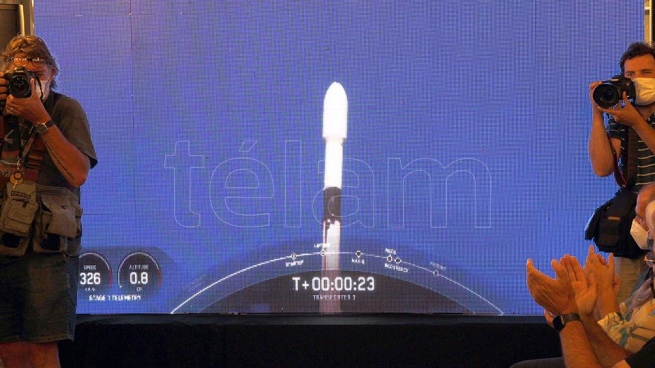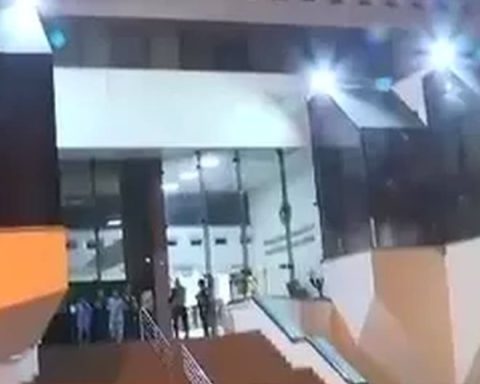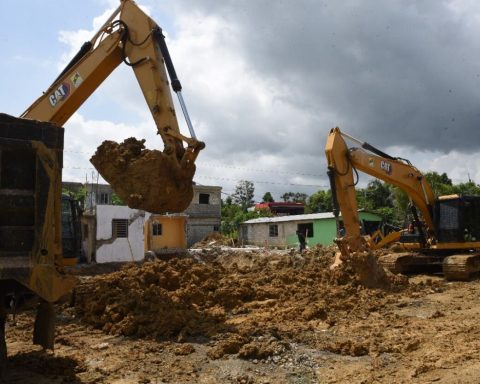The first Argentine communications minisatellite, a project that was born in the Technical School Nº 5 of Mar del Plata, was launched from the Kennedy Space Center of Cape Canaveral, in the United States, in a mission that concluded successfully after one hour and a few minutes after takeoff.
At 12:35 on this Thursday, under excellent weather conditions, the Falcon 9 rocket of Space X, the company founded by Elon Musk, took off from the United States, with the Argentine picosatellite General San Martín and other 105 space devices on board.
“It is a dream come true,” the CEO and teacher Alejandro Cordero said excitedly, for whom this event was a “national and global historical event.”
Applause and shouts of “Argentina, Argentina” were heard at the headquarters of the company Innova Space in Mar del Plata, from where the teacher, the students who participated in the initiative and various officials followed the transmission of the space trip.
Eight minutes after takeoff, the Space X landed on Earth again after transporting the Argentine minisatellite, which for at least a year will monitor the national territory with the aim of providing Internet of Things (IdC, IOT) connectivity to rural areas. from the country.
“Aerospace sovereignty is going to be total with our thunderbolt, it is going to make us independent from everything,” said Cordero, the professor who designed this 461-gram picosatellite that fits in one hand with his students.
Finally, when the clock struck 1:29 pm, Cordero exclaimed: “Our mission is successful”, noticing that the General San Martín satellite was deployed in space and is already in orbit to begin its work.
“The cosmic kite is about to take off, Víctor Hugo (Morales) would say,” Cordera said incredulously minutes before the launch of the picosatellite, “the first in Latin America of this size and with these specific characteristics,” he added.
It is a 10 x 10 x 5 centimeter satellite that will orbit in the LEO (Low Earth Orbit), a Polar Orbit at approximately 400-500 kilometers.

From there, the Argentine satellite “will turn the Earth once in 92 minutes” and, depending on the geographical location, it will visit Argentine territory a number of different times: “It will pass approximately four times through Mar del Plata, once a day through Jujuy , but by Ushuaia 10 “times, explained the professor.
Its objective is to provide access to the internet and other telecommunications services to 70% of the country that “is without any type of communications coverage.”
The recently launched, called General San Martín, is the first of a hundred satellites that make up the constellation “Libertadores de América”, which will be succeeded by the picosatellite “Juana Azurduy”, the CEO announced.
Unlike the next ones, which will have a useful life of between three and four years, this one is between one and two years, a “sufficient” life for its purpose.
Several national officials, led by President Alberto Fernández, welcomed this new aerospace initiative.
The President considered that the Argentines “have more sovereignty”, highlighting the launch this afternoon, stressed that “it will allow to connect and expand internet access”, and congratulated the group that developed the device in direct communication with Mar del Plata.
“That we can know issues as important as the weather of a country that needs to know to develop agriculture, livestock, to safeguard people from eventual rivers that overflow, rains and inclement weather; this is sovereignty,” said the chief of State.
The Minister of Productive Development, Matías Kulfas, pointed out that “the launch is the result of a public policy such as the Knowledge Economy Law, giving incentives to a sector that has an enormous capacity to generate value, qualified jobs and show young people that the exit is not Ezeiza “.

The Minister of Science, Technology and Innovation, Daniel Filmus, for his part, stressed that “the Argentine picosatellite not only signifies a new step towards the generation of sovereignty in the aerospace and communications field, but also with the image of the Islands Malvinas and the name given to it as General San Martín, disseminates and reaffirms our territorial sovereignty. “
Foreign Minister Santiago Cafiero highlighted that it constitutes “a milestone for the national industry. The satellite will allow companies that work in areas without connectivity to have access to the internet, thus improving their production,” he said from his Twitter account.
And from the National Commission for Space Activities (Conae) they congratulated Innova Space for the development of the first minisatellite in the region.
“We send our congratulations to Innova Space for the development it has carried out to have the first picosatellite in the region ready, San Martín, in Space,” Sandra Torrusio, manager of Technological Linking at Conae, told Télam.
Mini-satellites represent a new generation, the main advantage of which is the reduction of construction and launch costs, and are thus designated to all those weighing less than 500 kilos.
In turn, there are different subcategories and the term “picosatellite” is reserved for those that weigh between 100 and 1,000 grams, as is the case of the Argentine.
As for the internet of things, the term refers to the digital interconnection of everyday objects with the internet and without the intermediation of people.

“In two years we are going to launch more satellites than all of Latin America put together in all its history,” said the professor, who recounted the launch while some students remotely followed him and appeared on the screens at the Innova Space headquarters.
After recalling the disbelief with which many received the proposal -even, in part, himself- Cordera assured that this project started in 2019 and today completed in a first stage is “an achievement for human engineering because making a satellite in less than 9 months was almost impossible. “
The CEO also highlighted the importance of “the synergy between the private and the state”, and thanked the support and “the help of this Argentina that does not abandon us.”
“Argentina was encouraged and the results are here, they are tangible, the investment spills over into the local economy and the knowledge economy,” he added prior to the launch.
Among those present were the representatives of Neutrón, the project accelerator that made the initial investment, who celebrated this union between the public and private spheres, and of education with the productive sector.

















